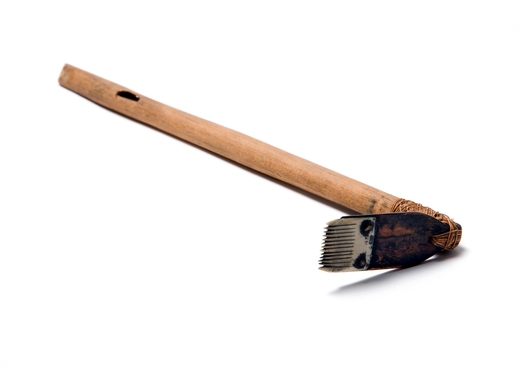
Tatooing tool, Samoa, mid-20th century. Copyright Australian Museum.
There are traditions of tattooing women and girls all over the world. Usually, tattoos mark the time of transition from girlhood to womanhood, just after puberty. And for females, it seems that the placement of the tattoos are in very visible and sensitive parts of the body: the chin, lips, forehead, fingers, and abdomen. One of the largest and most intense is the malu from Samoa. The malu covers the legs from just under the bottom to the tops of the knees.
This traditional tattooing comb was made in Samoa by an unknown tufuga tatatau (tattooing expert). Tattooing in Samoa is practiced by members of specific families and is very sacred. Made from coconut and shell, these tools are incredibly intricate to be able to make the different types of designs. The comb has sharp teeth that are dipped into black pigment, then hit so that it perforates and leaves the pigment under the skin. Getting the tattoo is a long and extremely painful process. It is a ritual that teaches girls to control their emotions and not give in to the pain. In the 19th century, only a chief’s daughter was permitted to wear the malu. It demonstrated her chiefly line as well as her inner mana (power). Meanings of the designs in malu have to do with shelter and protection.
From the late 20th century, girls of non-chief lines have received the malu tattoo. But today, getting traditional Polynesian tattoo designs is very popular among non-Samoans,even the malu. There are a few stories of non-Samoan girls having the malu done. This is controversial among Samoans. In a time of cultural appropriation and commercialization, people need to hold on to what is special, what is theirs. It isn’t about unwillingness to share, it is about power and continued colonization and exploitation.
-Ashley E. Remer
Head Girl
Girl Museum Inc.
This post is part of our 52 Objects in the History of Girlhood exhibition. Each week during 2017, we explore a historical object and its relation to girls’ history. Stay tuned to discover the incredible history of girls, and be sure to visit the complete exhibition to discover the integral role girls have played since the dawn of time.
